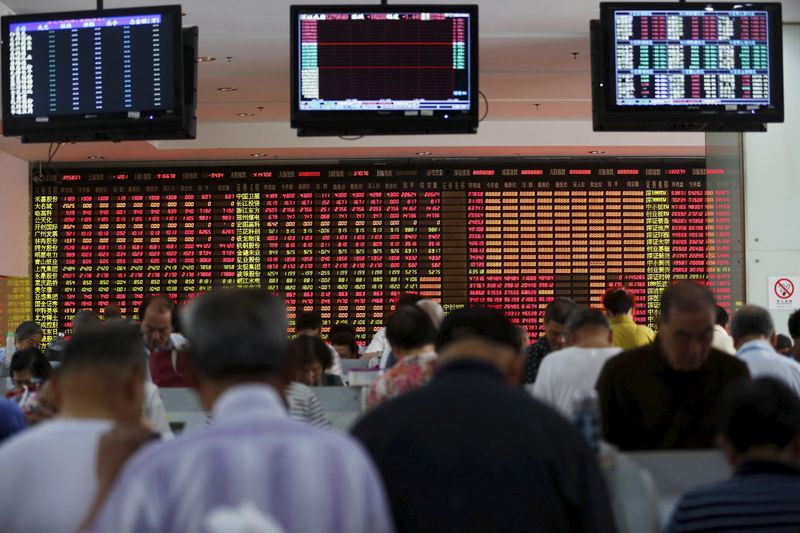By Pete Sweeney
SHANGHAI (Reuters) - China has enlisted $800 billion (512 billion pounds) worth of public and private money to prop up its wobbly stock markets, a Reuters analysis shows, but the impact of the unprecedented government-orchestrated rescue has so far been modest.
Public statements, media reports and market data reveal that Beijing unleashed 5 trillion yuan ($805.2 billion) in funds - equivalent to more than half of China's GDP in 2014 and greater than the 4 trillion yuan it committed in response to the global financial crisis - to calm a savage share sell-off.
But while the 2008 stimulus package staved off recession, analysts wonder what benefit the stock rescue package can bring to offset the risk the government is buying stocks at valuations private investors are no longer willing to pay.
"I'm quite negative towards the rescue," said Yang Weixiao, analyst at Founder Securities in Beijing.
"The problem is, all these measures only change the supply-demand relationship, without changing the fundamentals. So there's no real support, and the calm could be only temporary. If the governments exits the bailout, prices could accelerate their journey back to fundamentals."
Indeed, there are already some signs the government may be backing off from aggressive share purchases.
A plan to raise 100 billion yuan via short-term bills by China Securities Finance Corp (CSFC), the state-backed institution that provides margin financing, has been delayed, four sources familiar with the matter told Reuters on Monday.
On Thursday the CSFC admitted that it had reduced stakes in some listed companies to bring it below a regulatory threshold, but said it had transferred the shares, not sold them.
Respected private finance magazine Caijing also reported that the CSRC was considering withdrawing money from a stabilization fund, although CSRC denied the story.
It's hard to tell how much state money has actually flowed into the market, given the opacity of some of the investing institutions through which it has been channelled.
But Beijing's policy goal is not to prop up values by buying the stock market outright, but rather to entice private money back to the market, surfing a wave of incoming government money.
"Presumably the whole point is to say that you are going to spend this money, and then by saying it you don't actually have to spend it," said Andrew Batson, an economist at Gavekal Dragonomics in Beijing.
RESCUE PACKAGE
The combined measures, rolled out in a flurry of announcements earlier this month, included a 120 billion yuan stabilisation fund created by a core group of brokerages and 1.3 trillion worth of bank loans to state-backed margin finance companies.
Potential inflows created by tweaking investment rules for pension funds amount to 600 billion yuan, while allowing insurers to invest up to 40 percent of their assets in stocks could generate an estimated 2.9 trillion yuan.
There have also been high profile share buybacks announced by key stakeholders, and funds invested by the state-owned asset manager Central Huijin.
All that followed a double-barrelled burst of monetary policy stimulus by the central bank in late June that also explicitly targeted stock market stabilisation.
But the response of private money to Beijing's enticements has been lukewarm.
While the market has stabilised, with the Shanghai Composite Index (SSEC) recovering around 17 percent from a low point struck on July 8, it is still far below the semi-official recovery target of 4,500 points.
Beijing has thus so far produced the equivalent of less than 1 index point gain for every $1 billion committed.
And its market stability remains untested given the large numbers of companies still subject to trading halts.
An analysis by Everbright Securities of fund flow data showed that while government flows into two mutual funds targeted for government intervention rose sharply in recent weeks, private inflows into new stock funds have collapsed.
The other major problem with Beijing's strategy, Batson at Gavekal Dragonomics pointed out, is that many Chinese firms are still trading at stratospheric valuations.
Even after the early-summer meltdown that saw markets shed around a third of their value in a little more than three weeks, the Shanghai Composite Index (SSEC) is still up nearly 100 percent from 12 months ago, with an average price-to-earnings ratio of 17.64 - higher than the Dow Jones Industrial average P/E of 16.12.
The average P/E on the Shenzhen stock exchange (SZSA) is 47.23, while the small-cap ChiNext growth board (CHINEXTC) is a heady 98.07.
"If valuations are mean-reverting over time, which a lot of people think they are, that means that valuations could go down in the future," said Batson. "Which means that whatever buying the government does today could end up imposing a longer-term financial cost."
